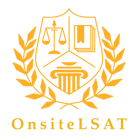Questions & Answers to the Most Relevant Subjects About LSAT Test Preparation
OnsiteLSAT is the culmination of more than 25 years of LSAT teaching knowledge, experience and wisdom. No other company can provide the same quality of test strategy and tactics combined with the mental tools necessary to conquer the psychological challenges of the LSAT that OnsiteLSAT offers. No other LSAT preparation company maintains the same commitment to live, in-person LSAT instruction with a ScoreCentric mission designed to help students reach their score goals as quickly as possible.
Cyberspace, with all of its distractions, sideshows and technological disruptions, is not the ideal environment for the practice of law, the study of law or the preparation for both.
More than anything, in-person LSAT prep forces students to focus and interact directly with their peers and instructor, which in turn prepares them to thrive, not only on the LSAT, but also within the walls of an actual law school classroom, a courtroom or an executive boardroom. OnsiteLSAT places a premium on the live, in-person experience, not only from a curriculum design and content delivery standpoint, but also in the site selection process for the classes themselves. In an OnsiteLSAT class, students learn in a professional environment that matches their future goals, not the classrooms that they have been daydreaming in for years.
Generally speaking, the time that it takes to prepare for the LSAT directly depends on how high a student’s score goal is relative to their initial baseline practice test score and the effort and energy that they consistently invest in their preparation.
The removal of the Analytical Reasoning section from the LSAT allows students to achieve their score goals faster, as there is less material to learn, master and practice. Additionally, there are numerous points of overlap between the reading comprehension and logical reasoning sections, making it easier to prepare for both sections in tandem.
If students prepare correctly the first time, they will be amazed at how quickly they can be ready for Test Day!
First and foremost, the LSAT heavily emphasizes deductive reasoning and the ability to interpret written prose. Inference questions, prominent in reading comprehension and to a lesser extent in logical reasoning, directly test a student’s ability to make deductions. Many standardized tests do not assess this skill, and when they do, it is typically in a much easier context.
Secondly, the LSAT extensively tests formal logic in the most difficult logical reasoning questions. Without an adequate understanding of formal logic, a subset of logical reasoning questions is virtually impossible to answer correctly.
Thirdly, each type of question on the LSAT adheres to a standard for accuracy. Only one answer choice, the correct one, will meet that standard, so all wrong answer choices are incorrect because they fail to meet that standard, not because they are inferior to the correct answer by matter of degree.
Starting with the August 2024 LSAT, the analytical reasoning section is no longer part of the test. Moving forward, the LSAT will contain three scored sections: one reading comprehension section and two logical reasoning sections. Additionally, there will be a fourth section that is experimental, does not count towards the LSAT score, can be either reading comprehension or logical reasoning and can occupy any position in the test’s section order.
The removal of analytical reasoning from the LSAT potentially eliminates numerous opportunities to test formal logic, which involves highly-technical deductions from if/then statements and their English language synonyms and equivalents. As a result of this change, OnsiteLSAT fully expects the amount of formal logic tested in logical reasoning to increase and has adjusted its curriculum accordingly.
Finally, the removal of analytical reasoning from the LSAT means that students have much less material and fewer strategies to learn in order to adequately prepare for the test and to achieve or to exceed their score goals. Large corporate test preparation companies want to keep students around for as long as possible to drive online engagement and to build their brand. However, given this significant change in the LSAT format, planning for and paying for 6–12 months of test preparation makes little sense. Simply put, with proper preparation from the right company, students can complete their preparation much faster than ever before.
The writing sample has always been a vastly underestimated component of the LSAT and the law school application as a whole, both by applicants and test preparation companies. The reality, especially in the age of AI, is that the writing sample is the only part of the application that law schools can objectively verify as your own work. In theory (and in practice for the less honorable and ethical), anyone could write your personal statement, resume and smaller application essays. As the only piece of writing that law schools know was authored by the applicant with absolute certainty, the writing sample is a crucial part of the law school application. It is imperative that it be taken seriously and be used as a potential strong point rather than merely checking a box.
As of July 30th, 2024, the writing sample is called Argumentative Writing. Candidates have 50 minutes total—15 minutes for pre-writing analysis and 35 minutes for essay writing (as opposed to 35 minutes total in the past).
For complete details of the new LSAT argumentative writing, please click HERE.
The psychological components of LSAT preparation and performance are just as important, if not more important, than learning the physical content. Even the most academically-astute test takers can be blindsided by the actual test-day experience if they are not mentally prepared.
OnsiteLSAT takes the psychological components of LSAT preparation and test-day performance far more seriously than its competitors and incorporates this throughout all of its materials, content delivery and advice.
